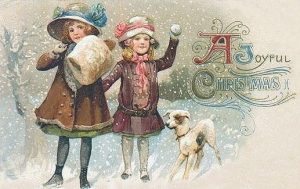 Lazy historians typically date the advent of Christmas cards to the 1840s, a time when postal services in modern western societies were well established and became more affordable. The truth is that the sending of holiday greetings is centuries old. Commercial Christmas cards got their start in the UK in the 1840s, suspiciously around the same time as the explosion in popularity of all things Christmas — from trees to holly, as spurred by popular Christmas-themed works such as Dickens’ A Christmas Carol.
Lazy historians typically date the advent of Christmas cards to the 1840s, a time when postal services in modern western societies were well established and became more affordable. The truth is that the sending of holiday greetings is centuries old. Commercial Christmas cards got their start in the UK in the 1840s, suspiciously around the same time as the explosion in popularity of all things Christmas — from trees to holly, as spurred by popular Christmas-themed works such as Dickens’ A Christmas Carol.
The tradition of holiday greetings, however, dates back centuries, most famously noted in the Bible when angels conveyed “glad tidings of great joy” to the shepherds abiding their flocks by night. Christmas greetings have been conveyed in person, in song, in poetic script, by letter and, yes, in the form of Christmas cards almost ever since.
Sending gifts or greetings in the form of something written was a Roman tradition of the New Year. Typically something was sent on December 25th to ensure they arrived by January 1st. Though Christmas was rarely mentioned in this practice it was implied in many cases.
The sending of holiday greetings is also tied to the ancient practice of mumming, when neighbors would go door to door dressed in costumes, seeking treats and conveying well wishes for the new year with short plays mocking church and authority and performing skits and songs of general merriment. This grand tradition, often related to modern celebration of Halloween, in some places got out of hand as crowds grew large and rowdy.
A favored twist on the tradition of mumming is Christmas caroling, typically tied to Victorian era England when singers would gather on street corners or go door to door singing tradition tunes set to holiday lyrics. Caroling was frequently viewed in place of gift giving by groups or individuals who lacked resources in gifting.
The mid-19th century popularity of Christmas as a secular event, fueled by the Queen’s much publicized adoption of the German tradition of Christmas trees and Charles Dickens’ book, A Christmas Carol, gave rise to many “new” traditions of the season, including the practice of sending Christmas cards.
In 1843 Sir Henry Cole commissioned artist John Callcott Horsley to create greeting images to be sold as the first Christmas cards commercially available.
Horsley was no run-of-the-mill artist. He was a shrewd businessman. He invented what was then called the Horsley envelope, a pre-paid mailing envelope that was a precursor of sorts to the postage stamp. The combination of inexpensive art and commercially available guarantee of delivery was a fad Cole and Horsley hoped to profit from in the short-term, never dreaming their enterprise would result in a long-standing Christmas tradition.
In fact, Christmas was just an extension of what they considered a broader market for the product. The cards made their debut in the month of May 1843 and included non-seasonal designs that eventually drew little interest. Their Christmas cards – absent then of most iconic holiday art and symbols so prevalent today – featured flowers, family and charitable themes — captured the public’s attention during that Victorian era when all-things-Christmas proved so very popular.
The first card famously showed a family sitting to Christmas dinner. The card drew critics almost immediately as it depicted a small child drinking wine in celebration of Christmas with the family. Ironically, this controversy drew more attention to the novelty of Christmas cards and helped spur their sales.
Horsley would grow in fame in his later years for other art related activities. His works were exhibited at the Royal Academy, where later in life he served as Rector from 1875 to 1890. He notoriously made a name for himself during this time frame for objecting to the common practice of painting women who were nude, an opinion that caused others to nickname him “Clothes Horsley”.
Though small in number the first few seasons the practice grew popular as many families divided over immigration to America and used overseas mails to wish each other well at least once a year, commonly at Christmas.
In the mid-1870s, with Christmas now an official federal holiday in America, and Christmas the defacto mid-winter holiday of secular choice, Louis Prang, a New England printer, marketed the first successfully commercial Christmas cards in America that sold in the millions by the 1880s.
Prang ran into a lot of foreign competition by the turn of the 20th century thanks largely to German imports. World War I effectively ended that competition and gave rise to a more diverse and heavier kind of card (stuffed in envelopes as opposed to being post-card variety) that reflected the high times of the 1920s.
The expansion of American culture through advanced print media, then radio, and then television shaped the greeting card industry into a monster, with billions sold over the decades fueled by images and styles influenced by Hollywood, popular cartoons, sports, music and movies.
As time has progressed and technology has extended the reach of human contact the extension of Christmas greetings via social media, text, and electronic media has expanded with it.









